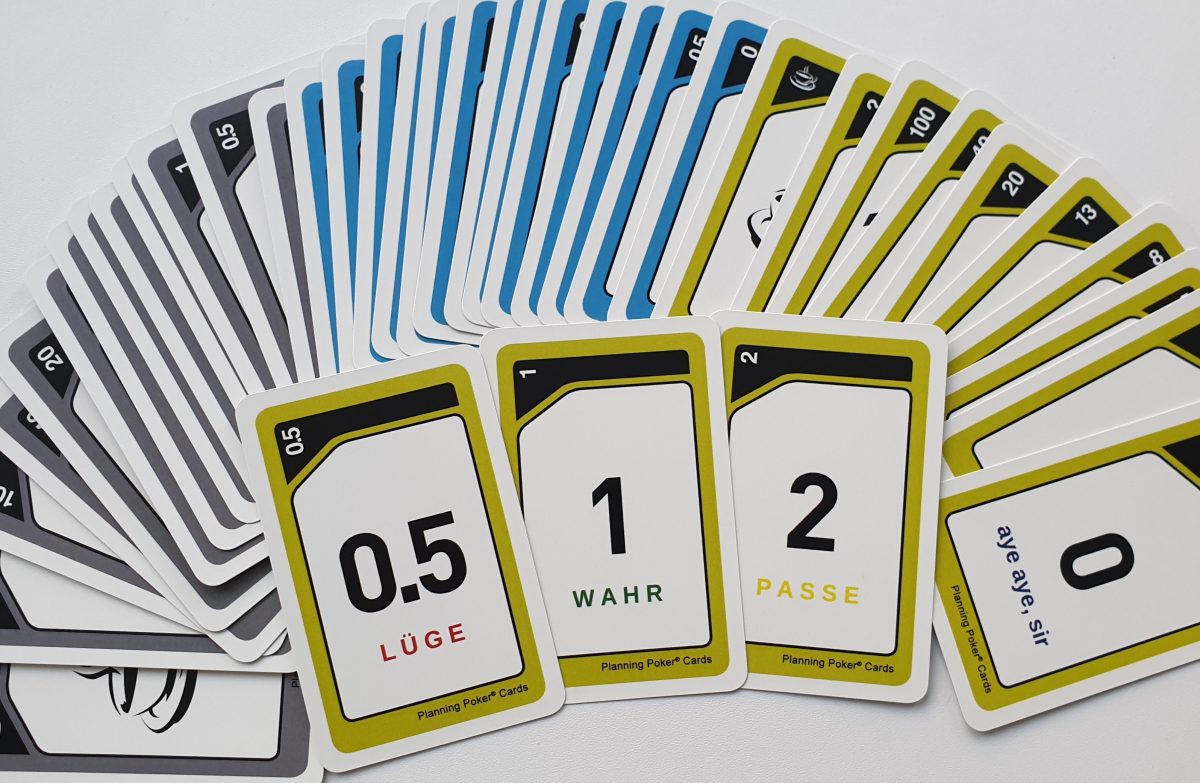Opinion Poker is a game that involves hearing the opinions of a group of people, providing a fun and playful starting point for anything else you might want to do. Once you know the simple rules, a round lasts about 15 minutes and is sure to be fun and exciting.
The aim is to keep others guessing about your true opinion while correctly assessing the accuracy of the other players‘.
BUSINESS VALUE
In a playful way, twice as many opinions as there are players are presented. Each player’s opinion is secretly recorded with a meaningful keyword and rated on the back. In a playful competition for the personal stake on offer, all opinions are impartially heard and discussed.
The game promotes team spirit, appreciative communication and creative thinking. It is the breeding ground for the successful planting of a „green field“ and will prevent premature development by HiPPOs (highest paid person’s opinion) or others who like to set the first anchor point.
MATERIALS
Planning Poker cards, pens and paper.
Preparation: Add the words ‚LIE‘, ‚TRUE‘ and ‚PASS‘ to the three lowest-value cards in each poker set, as shown in the picture. These cards will be used for betting.
G A M E P L A Y
[0.] Trigger
[1.] Pinpoint the topic
[2.] Set the stage
[3.] Write opinions
[4.] Sell opinions
[5.] Play poker
[6.] Settle
Let’s go, back to work with the result!
- Trigger
The trigger is the intuitive sense that it would be helpful to hear everyone’s opinions without them influencing each other, and that Opinion Poker would be a great way to achieve this. If you can convince the others of this, you’re good to go!
CAUTION! Only play with people who are willing to participate and feel comfortable with this game format. Don’t accept hesitant affirmations.
Pay attention to body language and observe carefully.
1. Pinpoint the topic.
In a brief and focused discussion involving all participants, the core topic — the question on which everyone has an opinion — is identified. Here, less is more, so there is no prior influence. Examples:
Why should we do this?
What should we do next?
How should we do this?
Who should do this?
Optional: Negation, hypothesis, exaggeration, change of perspective, or simply change of time, space, or persona.
- Set the stage
For the game to work, everyone must be genuinely motivated to win. Having a reasonable stake is fundamental and mandatory! There are no limits here. Be creative! Remember ‚Wetten, dass..?‘ The winner or loser can or must…
3. Write opinions.
ATTENTION! This step must be done secretly!
Each player already has an opinion on the topic and the reasoning behind it. Now, everyone is given time to come up with a false alternative opinion. A meaningful keyword is written for each opinion.
Why should we do this? Examples include reducing CO², standardisation and world domination.
What should we do next? Should we hold a workshop, consult with others, or just get on with it?
How should we proceed? Should we adopt Prussian correctness, Agile, or a playful approach?
Who should do it? You, them, or someone else?
On the back of the slip of paper, add a clearly legible plus sign (+) for your preferred option and a minus sign (–) for the alternative. Each player places their cards in front of them with the keyword facing up so that the other players can see them.
Optional: 1–2 minute time box.
- Selling opinions
- Round: Each player decides which opinion and reasoning they will promote first, then begins. The order is not predetermined. Everyone can play to their heart’s content in terms of tactics. Acting talent and cunning are required.
2. Round: One after the other, the second opinion is presented. Contradicting yourself doesn’t bother anyone in this game. The aim is to deceive the other players into believing that the true opinion is a lie and the false opinion is the truth.
Optional: 1-minute timebox per opinion
- Poker
Once everyone is ready and has formed an opinion on the suggestions presented, the Opinion Poker cards can be used. Each player is given a full set of cards numbered from 0 to 100.
Step 1: Simultaneously and face down, each player places their three betting cards (LIE, TRUE, and PASS) on the opponent’s keywords. Only one betting card per opinion.
With three players, one of the opponent’s opinions remains exposed. With four players, even three opinions remain.
Step 2: Poker points are placed on your betting cards. Poker points are the numbers of the poker cards still in your hand. The higher the point value on the card, the higher the risk.
Optional: Place poker points in three or four consecutive rounds to give the player the opportunity to deceive, manipulate, and mislead their opponents with the amount of poker points bet.
With four players, you can add another PASSE card.
6. Settlement
Players take turns to explain their opinion and justify it. It is important that the explanation is given, and that the other players remain silent!
Optional: Allow laughter, crying or positive mime feedback.
Once everyone has shared their opinion, count the poker points.
The PASSE betting card is a pure bluff and will be ignored.
The poker points on the TRUE and LIE betting cards count for either the player who guessed correctly or the player who deceived their opponent.
If the TRUE card is next to a keyword with a plus sign (+) on the back or the LIE card is next to a keyword with a minus sign (–), the poker points count for the person who placed the betting card. Otherwise, they count for the person who concealed their opinion successfully.
Total up the poker points. Climb the winner’s podium! Place your bets. Optional: Pay out winnings.
Let’s get back to work.
Now comes the important part: transferring this into reality. Anything is possible! Save your emotions and the flow, and transfer the keywords in a way that helps you progress with your topic.
Have fun!
Aye.koeln

